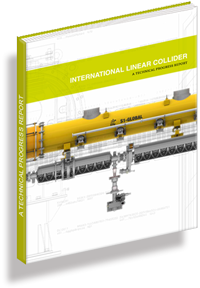The International Linear Collider is designed as the next large-scale experimental undertaking in elementary particle physics beyond the Large Hadron Collider, now in operation at CERN, Switzerland. Last week, the ILC Global Design Effort, led by Barry Barish, announced the release of the first of two progress reports on the ILC R&D programme and progress. The first report, The International Linear Collider: A Technical Progress Report, focuses on accelerator R&D and is oriented at establishing the technical viability of the design that will be presented in a future Technical Design Report by the end of 2012.
Complementing the Large Hadron Collider (LHC), the International Linear Collider (ILC) will continue the exploration of matter at the distance scale of 10‑18 metres – one-thousandth the size on an atomic nucleus. Scientists' current understanding of particle physics points to this distance scale as the key to the origin of the masses of the known elementary particles. It suggests that here, also, they could discover the particles that make up the dark matter of the universe.
The ILC will bring new high-precision tools that will help us solve these mysteries. Using unprecedented technology, the 31-kilometre-long ILC will hurl electrons and their anti-particles, positrons, toward each other at nearly the speed of light to collide 14,000 times every second at energies of 500 billion electronvolts (GeV). These spectacular collisions create an array of new particles that will answer some of the most fundamental questions about the nature of the universe, such as the origin of mass, dark matter, dark energy, extra dimensions and beyond.
| Organised by the Global Design Effort (GDE), a team of more than 60 scientists, the ILC is an international endeavour that brings together more than 1000 scientists and engineers from more than 100 universities and laboratories in over two dozen countries. The International Linear Collider: A Technical Progress Report marks the halfway point towards the GDE fulfilling its mandate with a more optimised Technical Design Report (TDR) by the end of 2012. The TDR will be based on much of the work reported here and will contain all the elements needed to propose the ILC to collaborating governments, including a technical design and implementation plan that are realistic and have been better optimised for performance, cost and risk. |  |
"We are on track to develop detailed plans for the ILC, such that once results from the LHC establish the main science goals and parameters of the next machine, we will be in good position to make a strong proposal for this new major global project in particle physics," said GDE director Barry Barish. "LHC results will likely affect the requirements for the machine design and the detectors, and we are monitoring that very closely, intending to adapt our design as those results become available."
This document represents a snapshot of the R&D status: a large fraction of the R&D projects continue through to the publication of the Technical Design Report in 2012, and in some cases beyond. Highlights of the achievements include the successful construction and commissioning of superconducting radiofrequency test facilities for accelerators all over the world, great strides in the improvement of accelerating cavities production processes, and plans for mass-production, as 16,000 superconducting cavities will be needed to drive the ILC’s particle beams.
“There is a strong physics case for a linear collider and we are confident that it will become even stronger with the incoming results from the LHC,” said Joachim Mnich, member of the International Linear Collider Steering Committee and DESY Director in charge of High-Energy Physics and Astroparticle Physics in Germany. “This report, a prime example for global collaboration, demonstrates that we have the technology at hand to rapidly move to a real project.”
The report also offers an extensive outline of the geological and civil engineering studies conducted for siting the ILC in the three major regions of consideration: the Americas, Asia and Europe. The ILC has already adopted international models for collaborative R&D programmes. All three regions involved in the ILC contributed to the report, reflecting the true international cooperation of the project.
The report is the first of two volumes and focuses on the collider, its design and technical aspects, and siting and safety considerations together with a realistic implementation plan, optimised for performance, cost and risk. A second volume, soon to follow, will focus on the ILC scientific case and on the design of the detectors associated with the collider.
-- From ILC News Release
Resources
- The International Linear Collider: A Technical Progress Report is available online as a pdf and can be ordered at: http://www.linearcollider.org/interim-report.
- Additional information about the ILC: http://www.linearcollider.org.
- Press information, fact sheets and images: http://www.linearcollider.org/press/.
